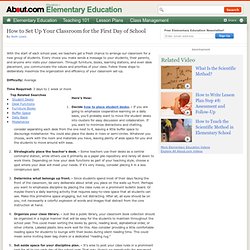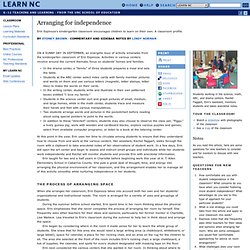

Classroom.4teachers.org/FloorPlanR.swf. Overview. Organizing Your Classroom. Setting Up Your Classroom. Classroom setup can dramatically affect students' attitudes toward and habits of learning.

Students need an environment that is organized, stimulating, and comfortable in order to learn effectively. Creating such an environment entails arranging a practical physical layout, supplying diverse materials and supplies, and encouraging students to have a sense of belonging and ownership. Tips for Getting Started Ask students where they think the different learning centers should go. Let students help to define what behavior is appropriate for each learning center.
Arranging the Learning Centers Take the physical features of your classroom into account when planning. Keep computers facing away from windows to keep glare from sunlight off the screens. Arranging the Whole-Group Area Make sure that all students will have an unrestricted view of the chalkboard. For whole=class lessons -- this includes informal discussion, direct instruction, and student presentations.
Small-Group Area Reading Area. Classroom Organization: The Physical Environment. Warm, well-run classrooms begin with the room's physical layout — the arrangement of desks and working space, the attractiveness and appeal of bulletin boards, the storage of materials and supplies.

Arranging Space The physical layout reflects your teaching style. If you want students to collaborate in small groups, for example, organize them around tables or clusters of desks. For frequent whole-group discussions, try a circle or U-shaped desk configuration. If you plan on an individualized, self-paced curriculum, you might set up learning stations. The physical layout should also reflect you. "Creating a caring, child-centered environment takes lots of thought and planning," says fifth-grade teacher Frank Garcia. Author and educator Mike Hopkins points out that personal teaching style and specific educational needs should largely determine how you design your classroom space.
Many teachers prefer to create different areas within the classroom. Desk Placement Environmental Preferences. Set Up Classroom - How to Set Up Classroom for First Day of School. With the start of each school year, we teachers get a fresh chance to arrange our classroom for a new group of students.

Every choice you make sends a message to your students, their parents, and anyone who visits your classroom. Through furniture, books, learning stations, and even desk placement, you communicate the values and priorities of your class. Follow these steps to deliberately maximize the organization and efficiency of your classroom set-up. Difficulty: Average Time Required: 3 days to 1 week or more Here's How: Decide how to place student desks. - If you are going to emphasize cooperative learning on a daily basis, you'll probably want to move the student desks into clusters for easy discussion and collaboration.
Tips: Check out your colleagues' classrooms. - Visit the classrooms of other teachers on your campus for ideas and inspiration. What You Need. Gallery: Prayers. Arranging for independence. On a sunny day in September, an energetic buzz of activity emanates from the kindergarten classroom of Erin Espinoza.

Activities in various centers revolve around the current thematic focus on students’ homes and families. In the drama center, a “family” of three students prepares a meal and sets the table. Students at the ABC center select index cards with family member pictures and words on them and use various letters (magnetic, letter stamps, letter tiles) to make the words on their cards.In the writing center, students write and illustrate in their own patterned books entitled “I love my family.”
Students in the science center sort and graph pictures of small, medium, and large homes, while in the math center, students trace and measure their hands and feet with various manipulatives. Two students arrange words and pictures in the pocketchart before reading aloud using special pointers to point to the words.
The process of arranging space Fostering independence Solving difficulties. Tools.